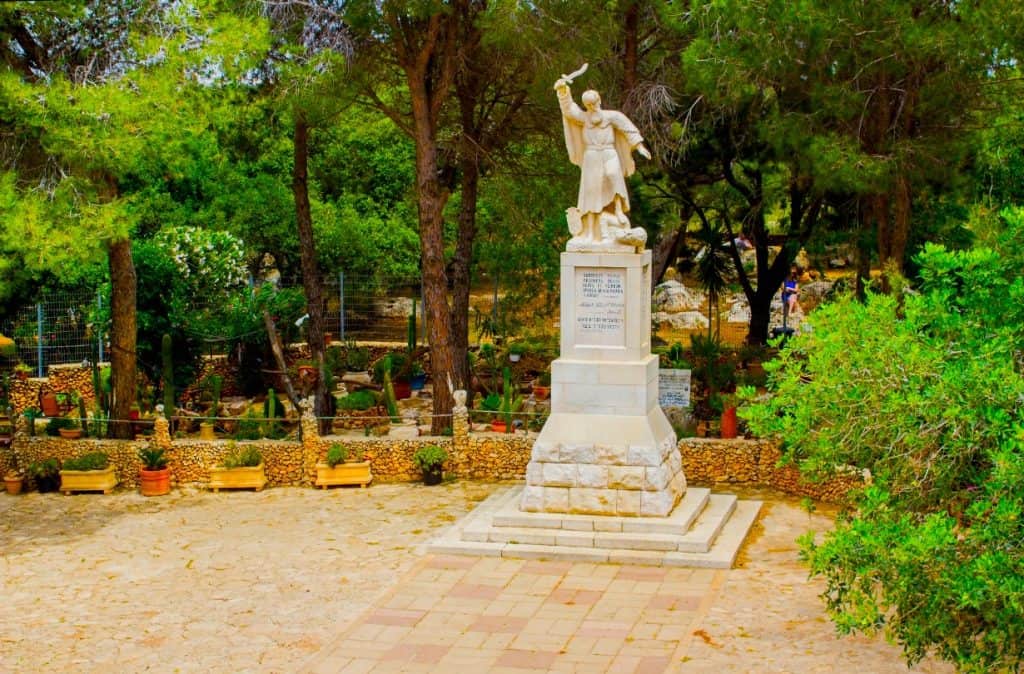A well-known biblical account concerning Elijah the Prophet took place on top of Mt. Carmel. But in order to understand that we need a little bit of context: It was when King Ahab ruled over the Kingdom of Israel in the 9th century BCE Ahab by marrying Jezebel, a priestess of Baal and the daughter of the King of Sidon in Phenicia, introduced foreign worship to the land.

Under Ahab’s kingship, tensions were exacerbated. Ahab built a temple for Baal, and his wife Jezebel brought a large entourage of priests and prophets of Baal and Asherah into the country. In this context, Elijah is introduced in Kings 17:1. He warns Ahab that there will be years of catastrophic drought because Ahab and his queen stand at the end of a line of kings of Israel who are said to have “done evil in the sight of the Lord”.
Deir Al Mukhraqa Carmelite Monastery On Mt. Carmel

As the Hebrew Bible tells, Elijah’s challenge is bold and direct. Baal was the Canaanite god responsible for rain, thunder, lightning, and dew. Thus, when he initially announces the drought, Elijah challenges not only Baal on behalf of God but also Jezebel, her priests, Ahab, and the people of Israel.
The Prophet Elijah Challenge the Baal
After Elijah’s confrontation with Ahab, God tells him to flee from Israel to a hiding place by the brook Chorath. After more than three years of drought and famine, God tells Elijah to return to Ahab and announce the end of the drought: not occasioned by repentance in Israel but by the command of the Lord, who had determined to reveal himself again to his people.
When Ahab confronts Elijah, he denounces him as the “troubler of Israel.” Still, Elijah takes notice of his hypocrisy and tells Ahab that he is the one who troubles Israel by allowing the worship of false gods. Elijah then rebukes the people of Israel and Ahab for their acquiescence in Baal worship.
“How long will you go limping with two different options? If the Lord is God, follow him; but if Baal, then follow him.”
The Book of Kings
and the People were silent. The Hebrew for this word, “go limping” or “waver”, is the same as that used for “danced” in 1 Kings 18, verse 26, where the prophets of Baal frantically dance. Elijah speaks with sharp irony about the religious ambivalence of Israel.

The Contest Between Elijah and the Prophets of Baal
Elijah proposes a direct test of the powers of Baal and the Jewish God. The people of Israel, 450 prophets of Baal, and 400 prophets of Asherah are summoned to Mount Carmel. An altar is built for Baal. Wood is laid on the altar. An ox is slaughtered and cut into pieces; the pieces are laid on the wood. Prophet Elijah then invites the priests of Baal to pray for fire to light the sacrifice.
They pray from morning to noon without success. Elijah ridicules their efforts.
“At noon Elijah mocked them, saying, ‘Cry aloud! Surely he is a god; either he is meditating, or he has wandered away, or he is on a journey, or perhaps he is asleep and must be awakened.'”
The Book of Kings
They respond by cutting themselves and adding their blood to the sacrifice (such body mutilation was strictly forbidden in the Mosaic law). They continue praying until evening without success.
Elijah Builds an Altar for the Gods of Israel
Elijah builds an altar from twelve stones, digs a huge trench around it, lays the wood on it, slaughters the ox, cuts it up, and lays it on the wood; he now orders that the sacrifice and altar be drenched with water from “four large jars” poured three times, also filling the trench.
He asks God to accept the sacrifice; Then fire falls from the sky, consuming the sacrifice; Next, the altar’s stones, the earth, and the water in the trench. Prophet Elijah then orders the deaths of the priests of Baal. Elijah prayed earnestly for the rain to fall again on the land. Then the rains begin, signaling the end of the famine. If you want to know more about Judaism, read my post on the Origins of Judaism.

